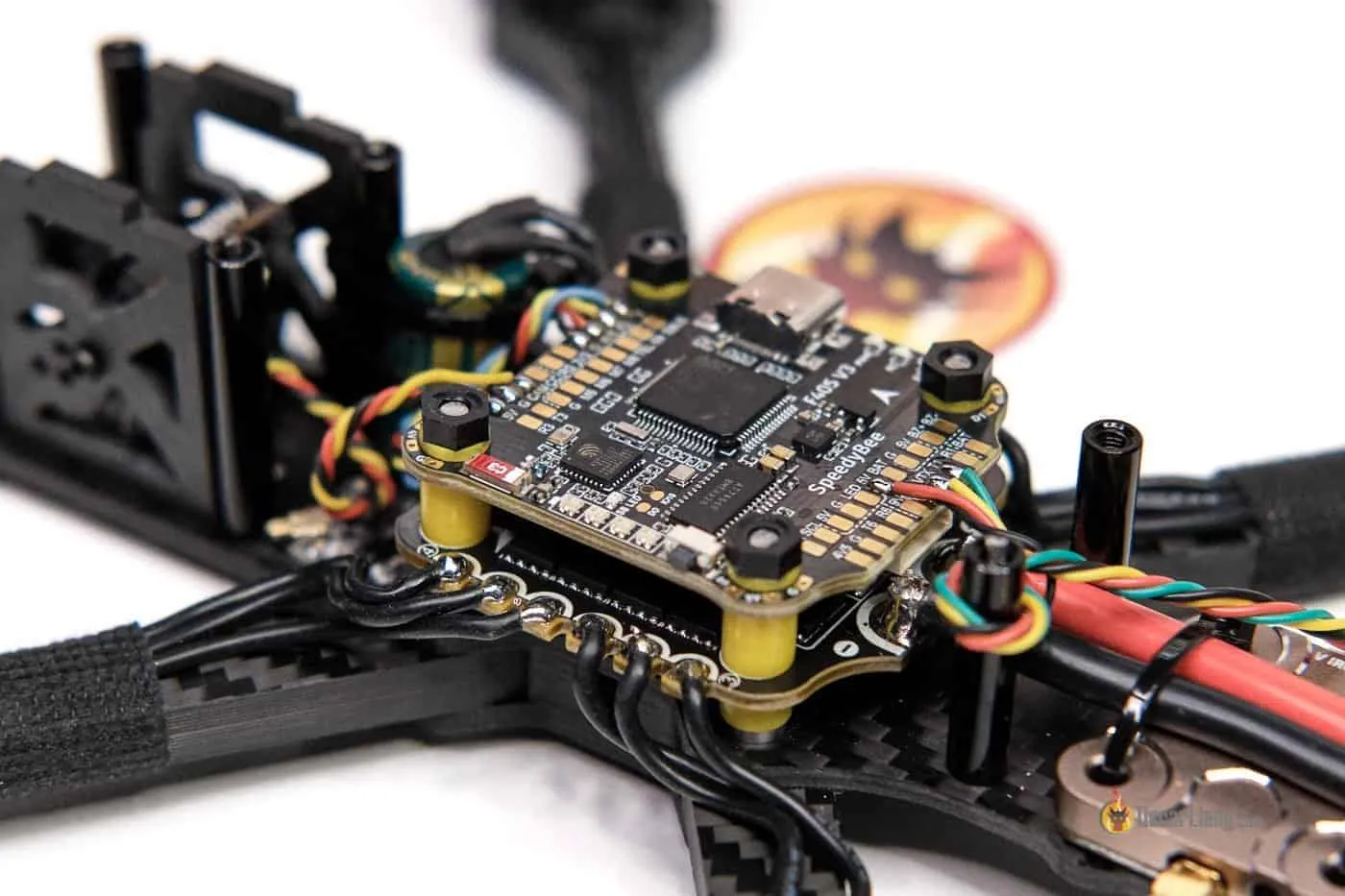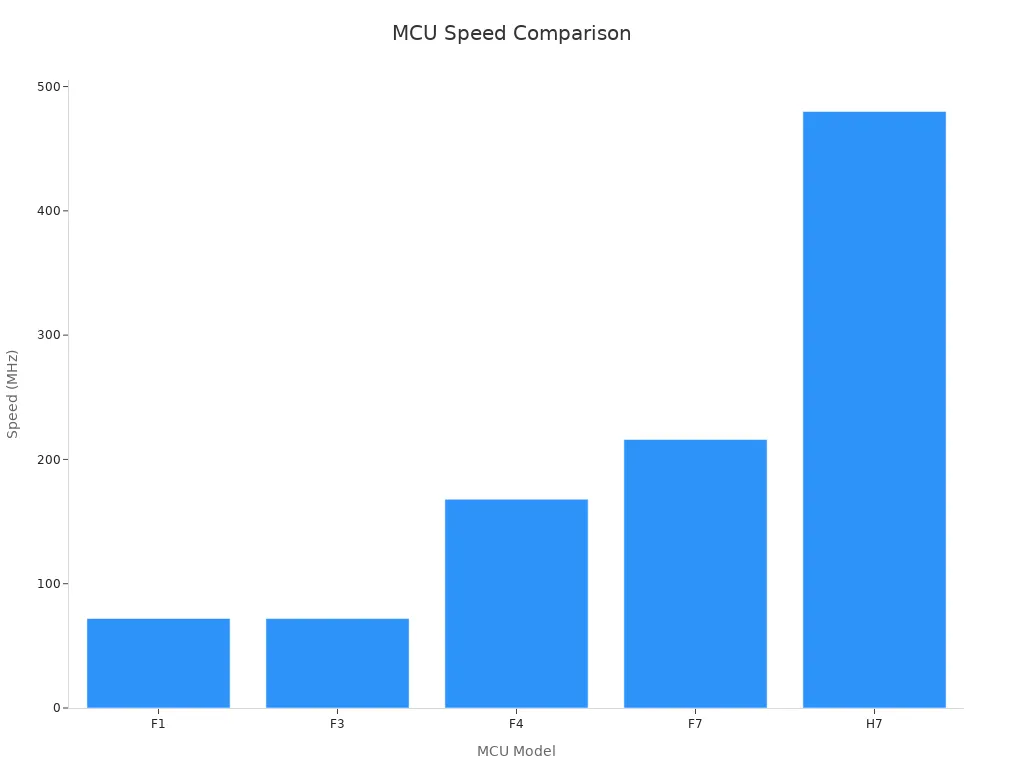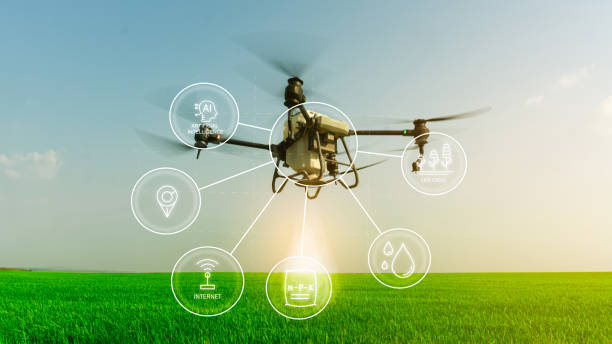How to Pick the Perfect Flight Controller Chip for drone from STM32 and NXP Kinetis

Choosing the right flight controller chip is very important for drones. The flight controller is like the drone's brain. It reads sensor data and keeps the drone steady. Modern drones need powerful chips with enough memory. This helps them do things like follow objects and adjust in real time. For instance, STM32 chips, like the F4 and H7 series, have at least 1MB of memory. This allows for future software updates. NXP Kinetis chips are strong and work well with many drone parts. Knowing these options helps drones work better and stay up-to-date in a changing industry.
Key Takeaways
Pick a flight controller chip based on your drone's job, like racing, taking pictures, or DIY projects.
Get chips with 1MB memory or more for updates and tough tasks.
Make sure it works with sensors and ESCs for smooth flying and fast reactions.
Check power use to make the drone fly longer, especially for farming or long trips.
Match your budget with needed features; spending more can mean better performance.
Understanding Flight Controller Chips
What is a Flight Controller Chip?
A flight controller chip is the drone's main processor. It works like the "brain," handling sensor data and giving commands. These chips are made to process data quickly in real time. They have parts like memory, pins for input/output, and connections for sensors. For example, STM32 chips come in different speeds and memory sizes:
MCU | Speed | Memory |
|---|---|---|
F1 | 72MHz | 128KB |
F3 | 72MHz | 256KB |
F4 | 168MHz | 512KB/1MB |
F7 | 216MHz | 512KB/1MB |
H7 | 480MHz | 1MB/2MB |
These features decide how fast and well the chip works.
Role of Flight Controller Chips in Drone Operation
The flight controller helps the drone fly smoothly. It uses data from sensors like gyroscopes and GPS. This data keeps the drone balanced and adjusts its position. Gyroscopes measure turning speed, and accelerometers track movement. Together, they make an IMU, which keeps the drone steady.
The flight controller also works with motor controllers to control motor speed. This teamwork lets drones hover, turn, or speed up easily. In FPV drones, it ensures quick responses for fast moves.

Why the Right Flight Controller Matters
Picking the right flight controller makes drones work better. Different drones need different controllers. Racing drones need fast chips for quick moves. Photography drones need stable chips for clear pictures. The chip's speed, memory, and connections affect how it performs.
Good cooling and strong signals are also important. A good controller stops overheating and keeps parts working together. This is very important for FPV drones, where smooth performance is key.
Key Factors to Consider
Processing Power and Performance
The flight controller's power affects how well it works. A strong processor helps the drone do hard tasks. These tasks include staying steady, tracking objects, and tricky moves. Chips like STM32 F4 and F7 are very fast. They let drones run many features at once without slowing down. F4 chips are good for simple drones. F7 chips are better for high-performance drones.
The processor also needs enough memory to store programs. Flash memory keeps the software and updates safe. Experts say 1MB of flash memory is a good choice. Keeping CPU usage below 75% stops overheating. This helps the drone stay stable during tough flights.
Compatibility with Drone Components
Sensors and Gyroscopes
The flight controller must work well with sensors. Gyros are very important for balance. They measure how the drone turns and help it stay steady. Newer gyros collect data faster, making drones respond quicker. Racing drones need fast gyros for sharp turns.
Other sensors like accelerometers, barometers, and GPS are also needed. These sensors help with height control, navigation, and auto-flying. The flight controller must support these sensors for smooth flying.
ESC Compatibility
ESCs control how fast the motors spin. The flight controller must match the ESCs in the drone. New ESCs use DShot, a fast communication system. A controller that supports DShot makes the drone more stable and quick.
Firmware and Software Support
Firmware is the program that runs the flight controller. It decides how the controller works and talks to parts. Popular firmware like Betaflight and Ardupilot have many features. They get updates to fix problems and add new tools. This keeps the drone modern and working well.
Software helps set up and adjust the flight controller. Easy-to-use software makes tuning the drone simple. This is great for beginners and hobbyists who are learning.
Power Consumption and Efficiency
Power use is very important for a flight controller. A good controller helps the drone work well without using too much battery. This is crucial for drones flying long distances, like farm drones or camera drones.
Modern controllers, like STM32 and NXP Kinetis, save energy. They have smart power features to use less energy when idle. For example, STM32 chips have low-power modes to make flights last longer. Similarly, NXP Kinetis controllers balance power and performance. This makes them great for drones that need to fly for a long time.
The firmware also affects how efficient a controller is. Good firmware helps the processor work without wasting energy. Developers adjust firmware to fit the drone's job, like racing, taking pictures, or farming. For instance, farm drones use firmware that focuses on steady flying and accurate navigation to cover big areas.
Tip: Think about your drone's battery size and flight time. A power-efficient controller can improve how well your drone works.
Cost and Budget Considerations
Flight controller prices depend on their features, speed, and brand. Cheaper controllers are good for hobby drones. Expensive ones, like those for racing or pro photography, have advanced features.
STM32 controllers are known for being affordable. The STM32 F4 series gives great performance at a fair price. This makes them popular with both beginners and experts. On the other hand, NXP Kinetis controllers cost more but are very reliable. Their higher price is worth it for some uses.
When planning your budget, think about the whole drone cost. This includes parts like sensors, ESCs, and batteries. A fancy controller might not be needed for a simple drone. But for business drones, like farm drones or city air systems, spending more on a top controller can improve results.
Note: Match your budget to your drone's needs. Spending extra on unneeded features won’t help simple projects much.
Comparison of STM32 and NXP Kinetis
Overview of STM32 Flight Controller Chips
Key Features and Strengths
STM32 flight controller chips are known for being flexible and fast. They come with different speeds, memory sizes, and advanced features. This makes them useful for many types of drones. These chips handle real-time tasks well, keeping drones steady in the air. They also work smoothly with popular firmware like Betaflight and Ardupilot, making them easy to use.
One great feature of STM32 chips is their ability to save energy. They have low-power modes that help drones fly longer without draining the battery. STM32 chips also support many sensors and gyros, which helps drones stay balanced and controlled. This makes them a top choice for FPV drones and other high-speed uses.
Popular STM32 Models for Drones
STM32 has models for different drone needs. The F4 series, like the STM32F405, is affordable and performs well. For harder tasks, the F7 and H7 series are faster and have more memory. Here's a table showing some STM32 models and their specs:
Processor | Processing Speed | Flash Memory | RAM |
|---|---|---|---|
F0 (STM32F051) | 48MHz | 256KB | 32KB |
F1 (STM32F103) | 72MHz | 128KB | 96KB |
F4 (STM32F405) | 168MHz | 1MB | 192KB |
F7 (STM32F745) | 216MHz | 1MB | 320KB |
H7 (STM32H743) | 480MHz | 2MB | 1MB |

Overview of NXP Kinetis Flight Controller Chips
Key Features and Strengths
NXP Kinetis flight controller chips are strong and dependable. They are great for professional drones where accuracy and stability matter most. These chips use advanced power systems to save energy during flights. They also connect quickly to sensors like gyros, helping drones stay steady.
Another benefit of NXP Kinetis chips is their toughness. They are built to handle tough conditions, like in farming drones or outdoor uses. These chips also work well with advanced firmware, making them easy to customize for different needs.
Popular NXP Kinetis Models for Drones
Popular NXP Kinetis models include the K64 and K66 series. These chips balance speed and energy use well. For example, the Kinetis K66 runs at 180MHz and has up to 1MB of flash memory. This makes it a good choice for drones with advanced features.
Head-to-Head Comparison
Performance and Processing Power
STM32 chips are usually faster, with the H7 reaching 480MHz. This makes them great for drones needing quick calculations and real-time changes. NXP Kinetis chips are slower but focus on saving energy and staying stable. This is helpful for drones flying long distances.
Compatibility and Ecosystem
Both STM32 and NXP Kinetis chips work well with flight controller firmware. STM32 chips are common in FPV drones because they support many sensors and gyros. NXP Kinetis chips are better for industrial drones where reliability is key.
Cost and Availability
STM32 chips cost less, making them a good choice for hobbyists and DIY projects. NXP Kinetis chips are pricier but offer more durability and stability. This makes them worth it for professional drones.
Choosing the Right Flight Controller Chip for Your Drone

Knowing Your Drone's Purpose
Racing Drones
Racing drones need to be fast and respond quickly. A flight controller with a strong processor is key. It should also have low delay and advanced gyro sensors. Support for fast systems like DShot helps with sharp turns. Freestyle FPV controllers focus on speed and quick moves. Chips like STM32 F4 and F7 are great for racing. They work well with firmware like Betaflight.
Photography and Videography Drones
Photography drones need smooth and steady flying. These drones often carry heavy cameras. The flight controller must help keep the drone stable. Controllers with H7 processors are good for clear visuals. Features like GPS and gimbal support are very important. Drone photography is growing, worth $1.2 billion in 2023. Picking the right controller is crucial for this purpose.
DIY and Hobbyist Drones
DIY drones are great for trying new ideas. These drones need controllers that are cheap but useful. STM32 F1 or F3 chips are good for simple projects. Hobbyists like controllers that are easy to use and flexible. These controllers are perfect for learning and customizing.
Matching Features to Drone Needs
Choose a flight controller based on your drone's job. Racing drones need fast processors and light designs. Photography drones need GPS and stable software. DIY drones need affordable controllers that work with many parts.
Criteria | Description |
|---|---|
Purpose | Pick based on what the drone will do. |
Price Range | Compare controllers in your budget. |
Features | Look for stability and needed functions. |
Tip: New gyro sensors make drones respond faster. Use them for better performance in freestyle drones.
Steps to Choose the Best Controller
Decide what your drone will be used for, like racing or photos.
Check different controllers and compare their features.
Pick one with at least 1MB memory for future updates.
Make sure it works with popular firmware like Betaflight.
Balance your budget with the features you need.
The right flight controller improves how your drone works. New technology makes controllers better for specific tasks. For example, STM32 F4 is great for racing drones. H7 controllers are best for professional photography. Matching the controller to the drone's job gives the best results.
Picking the right flight controller chip is very important. These chips are like the drone's brain, handling data and keeping it steady. STM32 chips, like the F4 and H7 series, are fast and affordable. They are great for racing drones and hobby projects. NXP Kinetis chips are tough and save energy. This makes them perfect for professional and industrial drones.
Here’s a table comparing STM32 F4 and F7/H7 chips:
Specification | F4 Chips | F7/H7 Chips |
|---|---|---|
Flash Memory | 512KB - 1MB | 1MB or more |
Recommended Looptime | 4K | 8K |
Number of UARTs | 2-3 (Small drones) | 5-6 (Bigger drones) |
CPU Usage Indicator | Under 75% when idle | Under 75% when idle |
Think about what your drone will do, like racing or farming. Match the chip’s features to your drone’s needs. This helps your drone work better and last longer.
What is an unmanned aerial vehicle (UAV)?
A UAV, or drone, is a flying machine without a pilot onboard. It uses flight controllers, sensors, and software to fly and do tasks. Drones are used in farming, photography, and delivery services.
How are drones transforming the agricultural industry?
Drones are changing farming by making it more precise. They check crops, spray chemicals, and study soil health. This saves money, works faster, and grows more food. Drones are now a key tool for modern farms.
Tip: Using drones in farming can save resources and cut waste.
What are the latest trends in drone technology?
Drone technology is improving quickly. AI drones, like Skydio 2, use smart tracking. Manned drones, such as Ehang EH216-S, are getting certified for city use. These trends show drones are shaping automation and transport.
Can drones be a profitable business venture?
Yes, drones can help start a successful business. Farming, real estate, and delivery companies use drones to save time. Offering services like aerial photos or crop checks can make good money with proper planning.
What is the future of drones in the next five years?
Drones will likely use more AI for smarter flying. City air travel with manned drones may become common. Farming drones will grow in use, and drones will change more industries, becoming vital tools for work.
Prediction: By 2028, drones may lead in city deliveries and smart farming.
CALL US DIRECTLY
(+86)755-82724686
RM2508,BlockA,JiaheHuaqiangBuilding,ShenNanMiddleRd,Futian District,Shenzhen,518031,CN
www.keepboomingtech.com sales@keepboomingtech.com
